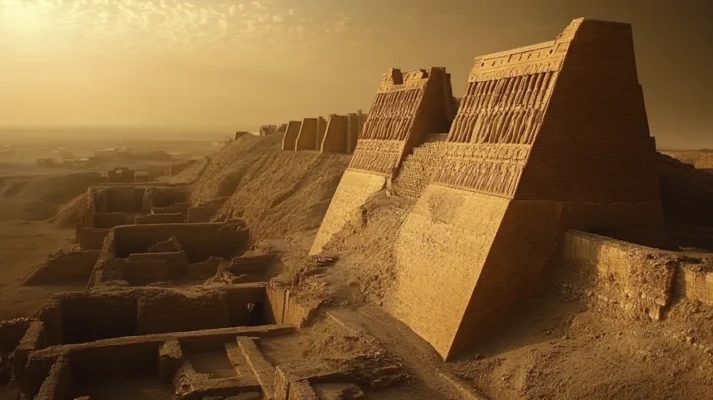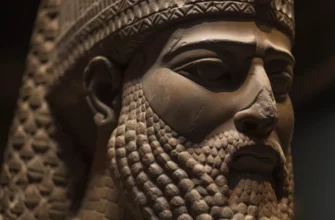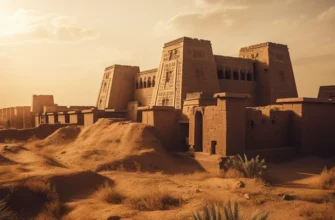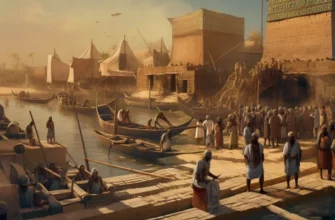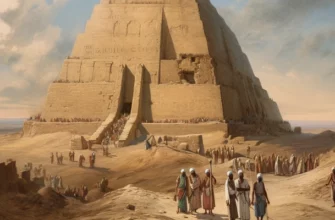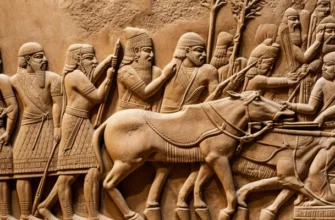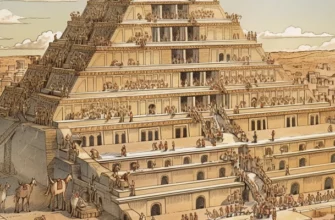Kish is one of the oldest cities in the world, located in Mesopotamia, in what is now Iraq. This city was an important center of the Sumerian civilization, considered one of the cradles of human culture. Known for its influence on the development of architecture, trade, and culture, Kish played a key role in the life of the Sumerians.
Founded around 3000 BC, the city was considered an important political and religious center. In Sumerian mythology, Kish had a special status, as it was here that human civilization began to recover after the Great Flood.
The legendary rulers of Kish went down in history thanks to ancient texts that reflect their power and wisdom. The architecture of Kish was impressive with its temples, monumental ziggurats, and strong walls.
Thanks to its location, the city became a hub for international trade, connecting Mesopotamia with India and the Mediterranean.
Modern archaeological excavations have uncovered numerous artifacts, including clay tablets with cuneiform writing, statues of gods, and household items. These finds make it possible to reconstruct the life and beliefs of the Sumerians. Kish remains a vivid symbol of the Sumerian civilization, which laid the foundations for the development of humanity. Its legacy inspires researchers and preserves the memory of one of the greatest cities of the ancient world.
- Location of Kish
- First settlements
- The beginning of life in Kish: archaeological finds.
- Architecture and urban structures
- Temples and ziggurats
- Residential quarters
- The role of the city in the administration and cultural development of Sumerian civilization
- Rulers of Kish
- Myths and legends about Kish
- Economy and trade of Kish
- Trade routes
- Agriculture and crafts
- Archaeological research in Kish
- Archaeological finds
- Current state of the territory
- Conclusions
Location of Kish
Kish was located in the southern part of Mesopotamia, in modern-day Iraq, about 12 km east of the ancient city of Babylon. The city was built in a fertile valley between the Tigris and Euphrates rivers, which provided favorable conditions for agriculture and the development of civilization.
Kish occupied a strategically important place at the crossroads of trade routes connecting Mesopotamia with other regions, including Persia, India, and the Mediterranean. Thanks to its location, the city had access to resources such as water, clay for construction, and fertile soil, which contributed to its prosperity and influence in the region.
Today, the ruins of Kish are located near the modern Iraqi city of El-Khillah, and they are an important site for archaeological research that is helping to reconstruct the life of the ancient city.
First settlements
The first settlements in the Kish area appeared as early as the Neolithic period, when human communities began to settle in the fertile valleys between the Tigris and Euphrates rivers. Archaeological evidence shows that small settlements of farmers and herders existed here as early as 4000 BC. Thanks to the favorable climate and access to water, people grew barley, wheat, legumes, and raised livestock.
Around 3000 BC, Kish became one of the first city-states of Sumer. Local residents began to actively build mud-brick houses, develop an irrigation system for irrigating fields, and engage in crafts. This marked the beginning of its heyday as an important economic, political, and cultural center.
Kish played a key role in the formation of Sumerian civilization, becoming a place where urban organization, division of labor, and the first administrative structures emerged. Its early inhabitants left behind a rich archaeological heritage that allows us to imagine how society was formed in ancient times.
The beginning of life in Kish: archaeological finds.
Archaeological excavations in the Kish area have revealed evidence of life in this area as early as the 4th millennium BC. Among the most important finds are the remains of mud-brick buildings, which are examples of early Sumerian architecture, as well as irrigation canals, which testify to the high level of organization of agriculture.
Cuneiform tablets found during the excavations have become key artifacts for understanding the culture and administration of Kish. They contain records of trade transactions, administrative orders, and religious rituals. These tablets indicate that Kish was an important administrative center even in the early stages of its existence.
The artifacts also include pottery, tools, and jewelry, which indicate the developed craft traditions of the city’s inhabitants. Religious objects, such as statues of gods, confirm the important role of spiritual life in society.
These findings demonstrate that Kish was one of the first centers of civilization where the foundations of urbanization, culture, and technology began to form, which later influenced the development of the entire region.
Architecture and urban structures
The architecture of Kish is a striking example of the building art of the Sumerian civilization. The city was distinguished by its well-thought-out layout, which included public buildings, residential quarters, defensive walls, and irrigation infrastructure.
One of the most notable architectural structures in Kish were the ziggurats — massive multi-tiered temples built of clay and mud bricks. These structures served religious and administrative functions, and their upper levels were used for religious ceremonies.
The ziggurats symbolized the connection between heaven and earth, which was central to Sumerian mythology. The residential quarters of Kish consisted of houses built of mud bricks, which provided coolness in the hot climate. The houses often had inner courtyards where residents spent part of their lives.
The city center was home to craftsmen’s workshops and bazaars, evidence of a vibrant economic life.
Kish’s defensive walls, built to protect against enemies, were among the strongest in the region. In addition, archaeologists have discovered the remains of complex canals that supplied the city with water and contributed to its prosperity.
The architecture of Kish demonstrates not only the technical achievements of the Sumerians, but also their ability to organize space to meet religious, social, and economic needs. These structures have left a significant mark on the history of the ancient world.
Temples and ziggurats
The temples and ziggurats of Kish were central elements of the city’s architecture, reflecting the deep religiosity and cosmogonic beliefs of the Sumerians. These structures served not only as places of worship for the gods, but also as administrative and social centers of the community.
Ziggurats, often referred to as “stairs to heaven,” were multi-tiered pyramidal structures built of mud and fired bricks. The most famous ziggurat of Kish, dedicated to the goddess Inanna, was an architectural masterpiece of its time. It consisted of several platforms, each smaller than the previous one, with a sanctuary at the top. Ziggurats symbolized the connection between heaven and earth, embodying the Sumerians’ desire for the divine.
The temples in Kish were built in the form of rectangular structures with inner courtyards. They were decorated with reliefs and sculptures of gods who guarded the sacred places. Inside the temples, religious rites, sacrifices, and ceremonies related to the worship of local deities were held.
These structures also had practical significance. Temples were often used as storage for grain and other resources, and ziggurats served as landmarks for travelers. They demonstrated the power and wealth of the city, remaining an integral part of the Sumerian cultural and political system.
The temples and ziggurats of Kish were not only impressive in scale, but also became centers of spiritual life that united the community. They are invaluable monuments of architecture and religious culture of the ancient world.
Residential quarters
The residential quarters of Kish were built to meet the needs of Sumerian society, combining comfort, protection, and accessibility. They were located near public buildings, markets, and craft workshops, which made everyday life easier for the city’s inhabitants.
The houses were built of mud bricks, which were readily available and kept the houses cool in the hot Mesopotamian climate. Typical dwellings were one or two stories high with flat roofs, which were used for storage or as additional living space in the evenings. In the middle of the houses there was usually an inner courtyard surrounded by living quarters.
In wealthier families, houses had separate rooms for food storage, utility rooms, and even small shrines for household gods. Simpler dwellings consisted of several rooms that were used for all living needs.
The city streets between residential quarters were narrow and winding, which helped reduce the impact of the sun. Some houses had direct access to the street, while others were connected by internal passageways.
The inhabitants of Kish were engaged in agriculture, crafts, trade, and temple services. Each neighborhood had its own specialization: crafts, trade, or residential, which contributed to the efficient organization of city life.
The residential quarters of Kish were not only a place of residence but also a center of social interaction, where traditions were formed and social ties were strengthened. Archaeological finds, such as pottery, jewelry, and tools, help to recreate the life of this ancient city.
The role of the city in the administration and cultural development of Sumerian civilization
The city of Kish played a key role in the administration and cultural development of Sumerian civilization, which in turn became the basis for the development of broader Mesopotamian culture and politics. As one of the largest cities in Sumer, Kish became an important political and administrative center, where not only administrative processes took place, but also control over neighboring territories was exercised. The city functioned as an important stronghold for the Sumerian kings, who sought to strengthen their rule through central authority, creating stability in the conquered lands. Due to its strategic location, Kish had a significant influence on the formation of political and administrative structures that became characteristic of Sumerian city-states.
Kish also had a major cultural influence. The city became the center of the development of Sumerian writing—cuneiform, which was used to record important events, laws, and religious texts. Numerous tablets with written records were created here, which are now the main source of knowledge about Sumer. In addition, Kish was an important religious center where huge temples and ziggurats were built, testifying to a deep religious life and cult practices that had a great influence on neighboring cities and cultures.
This city became an important cultural and artistic center where literature, religion, architecture, and art flourished. Kish contributed to the development of literary works, religious myths, and epics that reflected important aspects of the Sumerian world. In particular, the art of Kish was evident in architectural forms such as ziggurats and temple complexes, which became models for other cities in Mesopotamia.
Thus, Kish was not only an important administrative and political center, but also a cultural center that contributed to the development and spread of Sumerian civilization across large areas of Mesopotamia.
Rulers of Kish
The rulers of Kish occupied an important place in the history of Sumer, as their power was significant not only in the city itself but throughout Mesopotamia. The history of Kish includes several prominent figures whose reigns were decisive for the political and cultural development of the region.
One of the most famous rulers of Kish was Enmebaragesi, mentioned in the royal lists of Sumer. During his reign, Kish became a strong political center, and this ruler is known for his conquests in other cities of Sumer, as well as his significant role in uniting the Sumerian city-states under his rule.
He was not only a warrior but also an administrator, which helped Kish strengthen its political role in Sumer. Another prominent figure was Ur-Kagina, king of Kish, who, according to various sources, ruled the city during one of its most glorious periods.
He is known for his reforms in administration and social policy aimed at improving the lives of ordinary people and strengthening the state’s economy. Uruk-Kagina became popular among the people thanks to his efforts to promote justice and support local traditions.
Another famous figure was Shar-ki-en-shal, king of Kish, whose dynasty left its mark on the political history of Sumer. His reign was marked by internal stability and the development of foreign policy, which contributed to the establishment of Kish as one of the influential centers of Mesopotamia at that time.
Over the centuries, the rulers of Kish had a significant influence on the political situation in Sumer and Mesopotamia. They actively interacted with other major cities, such as Ur, Lagash, and Uruk, and often acted as mediators in conflicts between different cities. They also actively promoted the development of culture, religion, and the city’s economy and social structures, allowing Kish to remain an important political and cultural center for many centuries.
Myths and legends about Kish
Kish, as one of the largest and most famous cities of ancient Sumer, has many myths and legends that reflect its importance as a political and cultural center. These legends are often intertwined with historical events and characters, giving them special significance. Here are some of the most famous myths and legends associated with Kish:
The myth of the rise of Kish:
One of the myths associated with Kish tells how the city became one of the most influential in Sumer. According to this myth, Kish was chosen by the gods to become the center of power. The god Enlil, who was one of the main gods of the Sumerian pantheon, sent his blessing to this city, allowing it to become a political and cultural center. In this myth, the city is depicted as a place that received divine support to strengthen its position among other Sumerian city-states.
The myth of King Enmebaragesi:
One of the most famous myths associated with Kish concerns King Enmebaragesi, a ruler who, according to the Sumerian king lists, was the first king to unite Sumer. The myth tells that Enmebaragesi received a blessing from the gods to unite the scattered Sumerian cities and establish peace. This myth emphasizes the greatness and divine right of the rulers of Kish to hold political power over a large territory.
The myth of the great hero of Kish:
According to one of the legendary tales, Kish’s great role was connected with the famous hero Gilgamesh, king of Uruk, who, although he was the ruler of another city, took an active part in battles and political intrigues, where Kish played an important role. Gilgamesh often stopped in Kish during his travels, and according to some versions of the myth, it was Kish that became one of the places where he sought answers to questions about death and immortality.
The myth of Kish’s struggle with Ur:
In one of the legends, Kish and Ur became the main rivals for the domination of Sumer. The myth tells how the rulers of Kish and Ur fought for the right to rule all of Sumer. The god Enlil, who was the patron of Kish, gave his powers to the rulers of this city, allowing them to win battles, although Ur ultimately won a temporary victory.
The myth of the founding of the temple in Kish:
The legend also tells of a great temple dedicated to the god Enlil, which was built in Kish. The myth claims that this temple became not only a religious center, but also a place where important political decisions were made. The creation of the temple became a symbol of divine support for the city and its rulers.
The myth of divine rule:
In many legends, Kish is depicted as a city that derives its divine power from the gods, and the city’s rulers are considered representatives of the gods on Earth. This emphasized the importance of religion in the city’s administration and placed the rulers of Kish in a special position as having a divine mandate to rule. According to this myth, the kings of Kish did not simply rule over the people, but acted on behalf of the gods, which increased their authority among other cities.
The myths and legends of Kish reflect not only its political importance but also its cultural heritage. They testify to the greatness of the city and its role in the creation and maintenance of Sumerian civilization, emphasizing the close connection between religion, politics, and culture.
Economy and trade of Kish
The economy of Kish, like that of other city-states of Sumer, was complex and multifaceted, with a primary focus on agriculture, crafts, and trade. Thanks to its strategic location in the center of Sumer and its proximity to the great Tigris and Euphrates rivers, Kish had significant access to natural resources and was an important commercial and economic center.
Agriculture:
The economy of Kish was based on agriculture, which provided the city with food and raw materials. Thanks to the fertile land surrounding the city, farmers grew wheat, barley, fruits, vegetables, and cotton. Water from the Tigris and Euphrates rivers was an important source of irrigation, ensuring stable agricultural production.
Crafts and industry:
Kish was also an important center of crafts and industry. The city was famous for its pottery, textiles, metalwork, and ceramics. Local craftsmen produced a variety of items, including tools, weapons, and jewelry, which were not only used locally but also sold in other cities in Sumer and beyond.
Trade and commerce:
Kish had a favorable geographical location, which allowed it to be an important trading hub in Sumer. Kish merchants had access to goods from other parts of Mesopotamia and the Middle East. The city actively traded with other Sumerian cities, as well as with peoples living outside Sumer. This included trade routes that passed through Mesopotamia and connected Kish with various cultures, from which the city obtained metals, precious stones, fabrics, spices, and other goods.
Kish’s trade relations with Akkad, Uruk, Lagash, and other cities of Sumer were particularly important. Trade was conducted via rivers and caravans that traveled from city to city.
Climate and resources:
Despite the fertility of its lands, Kish was also dependent on external resources.
Metals such as copper and iron were not available in Mesopotamia itself, so Kish actively imported these resources through trade links. In turn, Kish exported agricultural products, handicrafts, and religious and cultural items.
Trade networks and communications:
Kish had a well-developed infrastructure for trade, including warehouses for storing goods, markets, and palaces for managing commercial operations. Kish’s trade relations also included joint activities with neighboring states, which allowed the city to increase its economic opportunities.
Banking and administrative control:
Merchants and entrepreneurs in Kish also used writing to keep records of transactions, debts, and commercial operations. Special bodies were established to control trade and the distribution of resources, which helped maintain stability in economic activity.
Thus, the economy of Kish was based on many aspects, including agriculture, crafts, and trade, which helped the city to prosper. Kish was an important commercial center not only in Sumer but also throughout the region, and its economic influence was felt not only within Mesopotamia but also beyond its borders.
Trade routes
The trade routes that passed through Kish were an important part of the city’s economic activity and ensured its prosperity. Thanks to its strategic location in the heart of Sumer, Kish became an important hub on the trade routes connecting Mesopotamia with other parts of the Near East, Central Asia, and even India. Trade along these routes was important not only for Kish, but for the entire Sumerian civilization, providing access to a variety of resources and goods.
River trade routes:
The main routes for the exchange of goods were the Tigris and Euphrates rivers. These rivers were important transport arteries that allowed goods to be transported from one city to another by water. Through the river routes, Kish was able to trade with other major cities of Sumer, such as Ur, Lagash, Uruk, and Nippur. The rivers also connected Sumer with other civilizations located within Mesopotamia, ensuring economic integration and the exchange of goods.
Caravan trade routes:
In addition to rivers, Kish was an important hub for caravan routes that passed through Mesopotamia and connected it with other regions. Merchants used camels and donkeys to transport goods overland via caravan routes that connected Kish with important cities such as Akkad, Elam, Mitanni, and even Antioch (in modern-day Syria).
These caravan routes ran through deserts, mountains, and plains, allowing for the transport of expensive goods such as metals, precious stones, spices, fabrics, textiles, and other goods. Trade routes through territories such as Syria, Arabia, and Iran connected Mesopotamia with other major trading centers of the Ancient Near East, helping Kish maintain its economic importance.
Routes to India and the Persian Gulf:
Another important trade route connecting Kish with distant regions was the route that ran to the Persian Gulf and on to India. Thanks to its location, Kish became an important transit point on the way to regions where merchants could deliver spices, precious stones, ivory, and other exotic goods. Trade with India contributed to the development of the economy and ensured the supply of goods that were not available in Mesopotamia itself.
Trade routes to Northern Mesopotamia and the Caucasus:
There were also trade routes from Kish to the north through Mesopotamia and the Caucasus. This route was important for the exchange of raw materials such as wood and metals, as well as handicrafts produced in Kish. Merchants transported goods to cities located in modern-day Turkey, as well as to various tribes living north of Mesopotamia.
Interaction with other cultures:
Trade routes through Kish also allowed interaction with other civilizations, including Elam (the territory of modern Iran), Akkad, and Assyria. Through these trade networks, Kish received not only material resources but also cultural influences that helped the city flourish and develop its art, religion, and technology.
Kish’s trade routes were an important element that contributed to its economic development and allowed the city to have great opportunities for the exchange of goods and cultural achievements. Kish’s trade networks connected Mesopotamia with other great civilizations of the time and contributed to the prosperity of not only Kish but also the entire Sumerian civilization.
Agriculture and crafts
Agriculture and crafts were the main pillars of Kish’s economy, contributing to its prosperity as one of the largest cities in Sumer. They provided the city with food, raw materials, and products necessary for daily life, as well as goods for domestic and foreign trade. Here is more information about agriculture and crafts in Kish:
Agriculture:
Agriculture was the foundation of Kish’s economy, as the fertile land, thanks to irrigation from the Tigris and Euphrates rivers, allowed for the cultivation of a variety of crops. Irrigation techniques were key to maintaining high yields.
Crops: The main crops grown in the vicinity of Kish were wheat, barley, fruits (dates, grapes, pomegranates), and vegetables (onions, garlic, beans). They were used as food for the city’s population and also exported to other city-states.
Livestock: Kish also raised animals such as sheep, goats, donkeys, and cattle. The animals provided the city markets with meat, milk, and leather and wool for crafts.
Irrigation: Thanks to irrigation technology, in particular canals built to control river water resources, agriculture was able to function even in a changing climate. The canals allowed for the expansion of farmland, which ensured high levels of production.
Crafts:
Crafts were an important part of the Kish economy. Handicrafts not only met the needs of the local population but were also exported to other cities and countries.
Ceramics and pottery: Kish was famous for its clay products, including ceramic vessels, clay tiles, and containers for storing water and grain. This was one of the main crafts in the city. Potters used special techniques to make pottery, which was often painted or decorated with relief images.
Metallurgy: Kish was an important center for metallurgy, particularly copper and gold processing. Local craftsmen made weapons, tools, utensils, and jewelry. Kish had trade links with other cities, which allowed it to obtain rare metals such as copper, which was then processed locally.
Textiles: The manufacture of fabrics and textiles was also an important part of Kish’s crafts. Woolen fabrics were produced, as well as cotton materials used for clothing and other items. Textiles were often decorated with embroidery reflecting cultural and religious themes.
Weaving and carpet making: Carpets and fabrics were made from sheep’s wool, and Kish exported a large part of its production to other cities in Sumer and neighboring territories. Weaving workshops used complex techniques to create intricate patterns.
Building crafts:
Kish was also famous for its architecture and building techniques.
Craftsmen created huge temples, palaces, and ziggurats, which were important religious and administrative centers. Architects and builders used bricks to construct large buildings and also employed techniques to conserve heat and ensure the strength of structures.
Stonemasonry and gemstone cutting:
Other crafts included stonemasonry and the working of precious stones such as lapis lazuli, obsidian, turquoise, and jasper. Craftsmen created decorative objects, seals, and jewelry that were important in religious and political ceremonies.
Shipbuilding:
Although rivers were the main means of transport for trade, Kish also had a developed shipbuilding industry. Boats and rafts used to transport goods along the rivers were important for trade and for maintaining links with other cities in Mesopotamia.
Agriculture and crafts were the basis of Kish’s economic power. Its favorable geographical location allowed the city not only to meet its internal needs, but also to actively participate in trade and exchange with other civilizations. Handicrafts, agricultural products, and irrigation technologies became the main factors in Kish’s prosperity, allowing it to be an important economic and cultural center of Sumer.
Archaeological research in Kish
Archaeological research in Kish is an important aspect of the study of ancient Sumer and its culture. As one of the oldest cities in Mesopotamia, Kish has left behind a rich archaeological heritage that allows researchers to study its history, culture, economy, and social structure.
The beginning of archaeological research:
The first archaeological research in Kish began in the late 19th and early 20th centuries. One of the first researchers was British archaeologist Lloyd M. Clark, who conducted excavations in Kish in the 1920s. However, intensive archaeological work in the city began later, in the mid-20th century.
Kish, as an important archaeological site, attracted attention due to its strategic location in the history of Sumerian civilization and the presence of numerous archaeological monuments, such as temples, palaces, tombs, and ziggurats.
Major archaeological finds:
Archaeological excavations in Kish have uncovered numerous artifacts that help researchers understand the daily life, religion, political structure, and cultural achievements of the Sumerians.
Ziggurat: One of the most significant archaeological finds is the ziggurat, a religious structure that symbolizes the architectural prowess of the Sumerians. The ziggurat in Kish was one of the largest in Mesopotamia. Excavations have revealed that it had steps leading to a sanctuary at the top where religious ceremonies were held.
Tombs and burials: Excavations have also uncovered several royal tombs containing rich burial gifts. This provides insight into the social structure of the city and the role of the rulers of Kish in society. The grave goods include gold jewelry, statues of gods, and important religious symbols, confirming the importance of religious beliefs for the Kish elite.
Pottery and crafts: A large number of pottery, tableware, seals, and textiles were found during the excavations.
This allows conclusions to be drawn about the crafts, trade, and daily life of the Sumerians, as well as their religious and cultural practices. Writing: Important archaeological finds include clay tablets with written records in Sumerian cuneiform script.
These tablets contain administrative documents, trade agreements, religious texts, and records of the rulers of Kish.
Urban structures and residential buildings: Excavations have uncovered the remains of residential buildings, palaces, administrative buildings, and commercial areas. This allows us to reconstruct the architecture of the time and study the social structure of the population of Kish.
Significance of archaeological research:
The archaeological excavations at Kish are important for understanding Sumerian civilization. They allow us to:
Study the political and religious organization of the city, as well as the interaction between different social classes.
Study architecture and construction techniques in ancient Sumer.
Assess the role of Kish in the economic and trade network of Mesopotamia, as well as its relations with other city-states.
Preserve cultural heritage and understand how the ancient Sumerians used various materials, including metal, clay, wood, textiles, and others.
Modern research:
Today, archaeological research in Kish continues. Modern technologies such as ground-penetrating radar and 3D scanning are used to study the deeper layers of the earth, allowing new archaeological sites to be discovered without the need for large-scale excavations. This helps to preserve archaeological sites and better understand what the city looked like at different stages of its development.
Archaeological research in Kish plays an important role in restoring the history of one of the world’s oldest civilizations. The study of the artifacts, buildings, and written materials found there provides a better understanding not only of the city itself, but also of the culture, religion, social structure, and economy of the Sumerians. Thanks to archaeological finds, Kish continues to be an important site for the study of ancient Mesopotamia.
Archaeological finds
Archaeological excavations in Kish have yielded a number of significant finds that allow us to study not only the material culture of this city, but also to reconstruct the social, economic, and religious aspects of Sumerian life. Here are some of the main archaeological finds made in Kish:
The Ziggurat of Kish:
One of the greatest archaeological finds in Kish is the remains of a ziggurat. The ziggurat was a large temple complex that served as the center of the city’s religious life. Archaeologists have uncovered the remains of a huge pyramid-shaped structure with numerous stairways leading to a temple at its top. The ziggurat was probably dedicated to the city’s main god. It is a testament to the high level of architectural and engineering skill of the Sumerians.
Tombs and burials:
Royal tombs and burials were important archaeological finds. The tombs contained rich grave goods, indicating the high social status of those buried there. Gold jewelry, precious stones, metal objects, and sculptures were found in the burials, confirming the wealth and power of the rulers of Kish. These finds provide insight into the burial rituals and beliefs of the Sumerians.
Pottery:
A large number of pottery items were found in Kish, including tableware, clay tablets, and tiles with relief images. Pottery was often decorated with geometric patterns or religious motifs. It was used to store food and water and for religious ceremonies. These finds help us learn about the daily life and customs of the Sumerians.
Cuneiform tablets:
One of the most important finds are clay tablets inscribed with cuneiform writing. This allows archaeologists to obtain direct evidence of the city’s administrative activities, economy, religious practices, and political organization. Some of the tablets contain records of trade agreements, population censuses, laws, and religious texts. These tablets are an important source for studying the history of Sumer and other civilizations of the time.
Metalwork:
Archaeologists have found numerous metal objects made of copper, gold, and silver. These include weapons, tableware, jewelry, and religious objects. Metal artifacts indicate the development of metallurgy in Sumer and the role of metal in religious and political ceremonies. For example, gold jewelry and statues of gods may indicate the ritual use of such objects.
Textiles and fabrics:
Archaeologists have also found remains of fabrics and textiles made from wool and cotton. This provides evidence of the development of the textile industry in Kish. They used fabrics to make clothing and for religious ceremonies.
Seals and amulets:
Seals made of clay, stone, or metal were an important means of authenticating documents and for religious rituals. They bore images of gods, rulers, or symbolic motifs. Archaeologists have also found amulets that were probably used for protection against evil spirits or for good luck.
Palaces and administrative buildings:
Archaeologists have excavated the remains of palaces, administrative buildings, and market areas. This provides insight into the organization of urban life and the role of Kish as an important administrative and political center. Large buildings probably served as residences for rulers, as well as places for meetings and administrative activities.
Tools and implements:
Agricultural tools, working implements, and technical devices used for land cultivation, pottery making, and other crafts have also been found in Kish. These objects show the level of technological and craft development in Sumer.
Archaeological finds in Kish provide valuable information about the culture, economy, and social organization of the ancient Sumerian city. They allow us to reconstruct not only everyday life, but also the political and religious structure of this great city, which played an important role in the history of Mesopotamia. Excavations at Kish continue, and new discoveries promise to reveal even more secrets of this great civilization.
Current state of the territory
The current state of the territory of Kish is complex and controversial. Located in southwestern Iraq between the Tigris and Euphrates rivers, the city was an important center of ancient Sumer, but today its territory is undergoing significant changes due to natural factors and human activity. Due to natural processes such as river course changes and irrigation projects, part of the territory of Kish has turned into a marshy area. The lack of proper care for archaeological sites, as well as political instability in the region, complicate the preservation of ancient ruins.
The archaeological sites of Kish, such as the remains of ziggurats, palaces, tombs, and other buildings, although important for the study of Sumerian civilization, suffer from the effects of time, erosion, vandalism, and illegal excavations. Modern archaeological research in Kish is limited due to a lack of funding and the complex security situation in Iraq, which also reduces opportunities for researchers from around the world to work in the region.
Preserving the cultural heritage of Kish requires significant effort, as archaeological sites are threatened by natural disasters, political conflicts, and a lack of infrastructure for their protection and maintenance. The monuments of Kish remain of great interest to scholars, but international initiatives and resources are needed to ensure their preservation and to restore and preserve this part of human history.
Conclusions
The study of Kish is extremely important for understanding the history of Sumerian civilization, as this city was one of its key centers in the early stages of development. Kish was not only an important political and religious center, but also played a significant role in shaping the social and economic structures of Sumer.
Archaeological finds made in the territory of Kish allow us to reconstruct the life of the Sumerians, their customs, beliefs, and daily activities.
Kish is an important testimony to the high level of development of Sumerian culture, particularly in such areas as architecture, art, crafts, religion, and public administration. Artifacts found in the city, such as clay tablets with writing, pottery, metal objects, and statuettes, help archaeologists and historians reconstruct the social, economic, and cultural organization of Sumer.
Kish was also an important commercial and military center, allowing us to assess the city’s role in the economic network of Mesopotamia. Analysis of the trade routes that passed through Kish provides insight into how the Sumerians interacted with other cultures and peoples of the time.
Thus, the study of Kish is critical to a fuller understanding of ancient Sumer and its place in the context of ancient civilizations. This city has become one of the main sources for reconstructing the history, cultural traditions, and achievements of the Sumerians, and its importance to archaeology and history cannot be overstated.
